Keeping tractor tires filled at the right pressure is important for getting the most out of your vehicle and staying safe on the road.
But adding air to your tires isn’t enough; when it comes to improving traction and stability on any terrain, filling tractor tires with water is an often overlooked but highly effective practice.
In this blog post, we’ll take a look at what you need to know about how to fill tractor tires with water in 2023—from understanding whether or not it’s the right choice for you to gather the materials required and following step-by-step instructions designed specifically for added safety.
So if you want all the need-to-know details on filling tractor tires with water correctly (and safely), read on!
Take away key points:
- Water is an inexpensive option for adding liquid ballast to tractor tires, but it can freeze in cold temperatures if not mixed with an antifreeze solution.
- Overfilling the rear wheels with water can cause damage to the tire’s rubber and in some cases, even cause the tire to burst or fail.
- To properly fill tires with water, a water-filling valve or tube should be used to avoid the risk of spillage or overfilling.
- Filling tires with water can help improve traction and stability, but other options like calcium chloride, anti-freeze, or beet juice may provide better results depending on your specific needs.
- It’s important to periodically check the pressure and weight of the tire and adjust the amount of water accordingly. Additionally, you may need to drain and refill the tires periodically to keep the water balanced and prevent damage to the tire.
Table of Contents
How to fill tractor tires with water: A step-by-step guide
Filling the tires of your tractor with water can give you a lot of benefits, like better traction, more stability, and less soil compaction.
Here’s a step-by-step guide to filling your tractor tires with water:
1. Determine the weight of your tractor
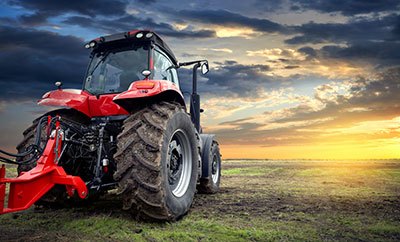
Before you start filling your tractor tires with water, you need to know the weight of your tractor and the tire size.
The easiest way to do this is to consult your owner’s manual or to contact the manufacturer.
2. Calculate the amount of water needed
Once you know the weight of your tractor, you can calculate the amount of water needed to fill the tires properly.
As a general rule of thumb, fill the tires to a level that provides 10-15% of the tractor’s total weight in ballast. For example, if your tractor weighs 10,000 pounds, you would want to fill the tires with 1,000-1,500 pounds of water.
Lastly, you can use water ballasting to re-stabilize an axle that is not in line with how the load is distributed on the implement. For instance, if there’s a lot of weight on your back tires, then fill up your front tires and vice versa when using a front loader.
This type of ballasting method may be used as an ongoing practice if always utilizing similar implements to front end loader and conditions; generally speaking, it ought to be 60% on your rear axle while 40% remains on the front one.
Gather your supplies
Before you get started, you’ll need a few supplies from the tire shop:
– Garden hose with a pressure nozzle
– Valve core removal tool
– Tire pressure gauge
Remove the valve cores
Using the valve core removal tool, unscrew the valve cores from the tire valves. This will allow the water to flow into the tire.
Insert the hose
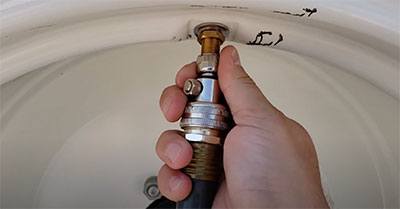
Attach the garden hose to the valve stem and turn on the water. You may need to adjust the pressure nozzle for the right flow rate.
Turn on the water
Slowly fill the tire with water. You can use a tire pressure gauge to monitor the pressure as you fill the tire. However, you have to let air escape several times through the hose.
Monitor the tire pressure
As you fill the tire, the pressure will increase. Be sure to monitor the pressure frequently and adjust the water flow rate accordingly.
Remove the hose
Once the tire is full, turn off the water and remove the garden hose from the valve stem.
Replace the valve cores
Using the valve core removal tool, screw the valve cores back into the valve stem.
Finish and test
Finally, check the tire pressure with a gauge and adjust if needed when you fill tire completely. Then, take the tractor for a test drive to ensure everything is working properly.
Maintenance tips
1. Regularly check the tire pressure
After filling your tractor tires with water, it’s important to regularly check the tractor tire pressure to ensure it stays at the proper level. As the temperature and weather conditions change, the pressure in the tires can fluctuate.
Use a tire pressure gauge to regularly monitor the pressure and add or remove water as needed to maintain the desired pressure.
2. Inspect the valves
Regularly inspect the valves on the tires for any signs of damage or wear.
Check that the valve cores are properly installed and tightened, and replace any damaged or faulty valves as needed.
3. Inspect the hoses
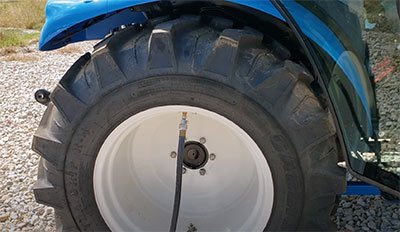
Inspect the hoses used to fill the tires with water for any signs of damage or leaks.
Check the connections to ensure they are tight and secure, and replace any damaged or faulty hoses as needed.
4. Store the tractor tires properly
When your tractor is not in use, it’s important to store the tires properly to extend their lifespan.
Park your tractor on a flat, level surface and avoid putting excessive weight on the tires. Cover the tires to protect them from sunlight and other environmental factors.
5. Maintain wheel alignment
Proper wheel alignment can help extend the life of your water-filled tractor tires. Regularly check the wheel alignment and make any necessary adjustments to ensure the tires are wearing evenly.
6. Drain and refill the tires periodically
Over time, sediment and other materials can build up in water-filled tractor tires.
It’s important to periodically drain the water from the tires and refill them with fresh water. This will help prevent corrosion and other damage to the tractor tire.
Benefits of water-filled tires
Water-filled tires can provide numerous benefits, such as improved traction and stability, reduced soil compaction, and better overall performance in wet conditions.
Here are some of the top benefits:
1. Improved traction
One of the main benefits of filling tractor tires with water is that you can increase traction.
Water-filled tires have more weight than air-filled tires, which can provide a better grip on the ground. This is especially beneficial in wet or muddy conditions.
2. Increased stability
Water-filled tires provide more stability for your tractor. The added weight can help prevent the tractor from tipping over when carrying heavy loads or working on uneven terrain.
Additionally, water is used in conditions when traction is needed for a lower center of gravity.
3. Reduced soil compaction
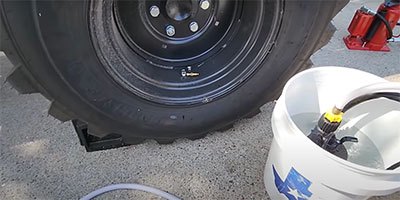
Water-filled rear tires can help reduce soil compaction. By distributing the weight of the tractor over a larger area, water-filled rear tires can reduce the amount of pressure placed on the soil, preventing damage and preserving soil health.
4. Better performance in wet conditions
Because water-filled tires provide better traction and stability, they can also improve performance in wet or muddy conditions. This can help boost efficiency and productivity in farming operations.
5. Cost-effective alternative
Water-filled tires are often more affordable than other types of tire weights, such as steel or calcium chloride. This can provide cost savings for farmers who need to add weight to their tractors.
6. Environmentally friendly
Water-filled tires are also an environmentally friendly option. Unlike other types of tire weights, water is a natural substance that is safe to dispose of and does not pose a threat to the environment.
Disadvantages of water-filled tires
1. Potential for freezing
If you live in an area where temperatures drop below freezing, water-filled tires can be prone to freezing. When the water inside the tire freezes, it can expand and potentially damage the tire.
To prevent the water from freezing inside the tire and potentially causing damage, it’s recommended to add an antifreeze agent to the water before filling the tire. Antifreeze prevents the water from freezing by lowering the temperature at which it freezes.
Additionally, storing the tractor indoors or in a heated storage area can also significantly reduce the risk of freezing.
2. Difficulty in adding or removing water
Unlike other types of tire weights, such as steel or calcium chloride, it can be more difficult to add or remove water from a water-filled tire.
You need access to a large amount of water to fill the tire, and removing the water can be time-consuming and messy.
3. Increased risk of corrosion
Water-filled rear tires can also increase the risk of corrosion. If the water inside the tire is not properly maintained, it can lead to rust and corrosion on the valve stems and other metal parts of the tire.
4. Reduced maneuverability
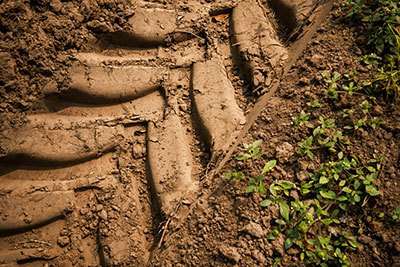
Because plain water-filled tires are heavier than air-filled rear tires, they can reduce the maneuverability of the tractor. This can be especially noticeable when turning or operating the tractor in tight spaces.
5. Risk of tire damage
If a water-filled tire gets punctured or damaged, it can be more difficult to repair than an air-filled tire. This is because the water can seep out of the tire and make it difficult to find and patch the hole.
Other liquid ballast options
1. Calcium chloride
Calcium chloride is a popular option for its ability to lower the freezing point of water, making it less likely to freeze. It also provides additional weight to the tire, improving traction and stability.
However, it can be highly corrosive to metal components and can cause damage to the tire’s rubber if overfilled.
2. Antifreeze
Antifreeze (propylene glycol) is another option that is able to prevent the freezing of the liquid ballast. It is also non-corrosive and non-damaging to the tire’s rubber.
However, it is more expensive than other options and may not provide as much weight for traction. You can use the safer version (propylene glycol) or the toxic version (ethylene glycol).
3. Beet juice
Beet juice is a newer option that is gaining popularity due to its eco-friendliness. It is non-toxic, non-corrosive, and biodegradable. It also has a higher density than water, providing additional weight for traction. However, it can be more expensive than other options.
4. Windshield washer fluid
Windshield washer fluid is a popular option for tractor ballast, as it can provide additional traction and stability to the tractor while still being lightweight and cost-effective. It also has antifreeze properties which make it less prone to freezing in cold climates.
Additionally, windshield washer fluid has a low risk of corrosion and damage to the tire’s rubber. However, it is not as heavy as other liquid ballast options and may not provide enough weight for greater traction.
Additionally, it can be difficult to remove from the tire once filled. Therefore, the windshield washer fluid should be used with caution when choosing a liquid ballast option for your tractor.
FAQs
Should I fill my tractor tires with water?
Filling tractor tires with water is an inexpensive option for adding ballast, but it can freeze and cause damage to the tire if overfilled.
Other options, such as calcium chloride or polyurethane foam fill, may be better depending on your specific needs. It’s best to research each option and consult with a professional before making a decision.
How much water should I put in my tractor tires?
As a general rule of thumb, water should make up approximately 40-50% of the tire’s total weight. To determine the correct amount of water to add to your tires, you can use a water chart or consult a professional.
Additionally, it’s important to periodically check the pressure and weight of the tire and adjust the amount of water accordingly.
Are fill tractor tires with fluid better than water?
Filling a farm tractor tires with fluid can provide better traction and stability than water alone.
There are different types of fluid fill options available, such as calcium chloride, antifreeze, or beet juice, and each one has its benefits and drawbacks.
What to do to prevent the water in the tractor tires from freezing?
To prevent water in tractor tires from freezing, you can add an antifreeze solution, and calcium chloride, or store the tractor in a warm area. It’s important to check the water levels regularly to prevent overfilling.
What tool is indispensable if I want to fill my tractor tires with water?
The tool that is indispensable for filling tractor tires with water is a water-filling valve or tube. This tool is specifically designed to fit onto the valve stem of the tire, allowing for easy filling without the risk of spillage or overfilling.
Conclusion
In conclusion, filling your tractor tires with water is a relatively easy process and can provide numerous benefits for your farming operations if you use the right tools.
By following the steps outlined above, you can ensure your water-filled tires are installed and maintained safely and effectively.
